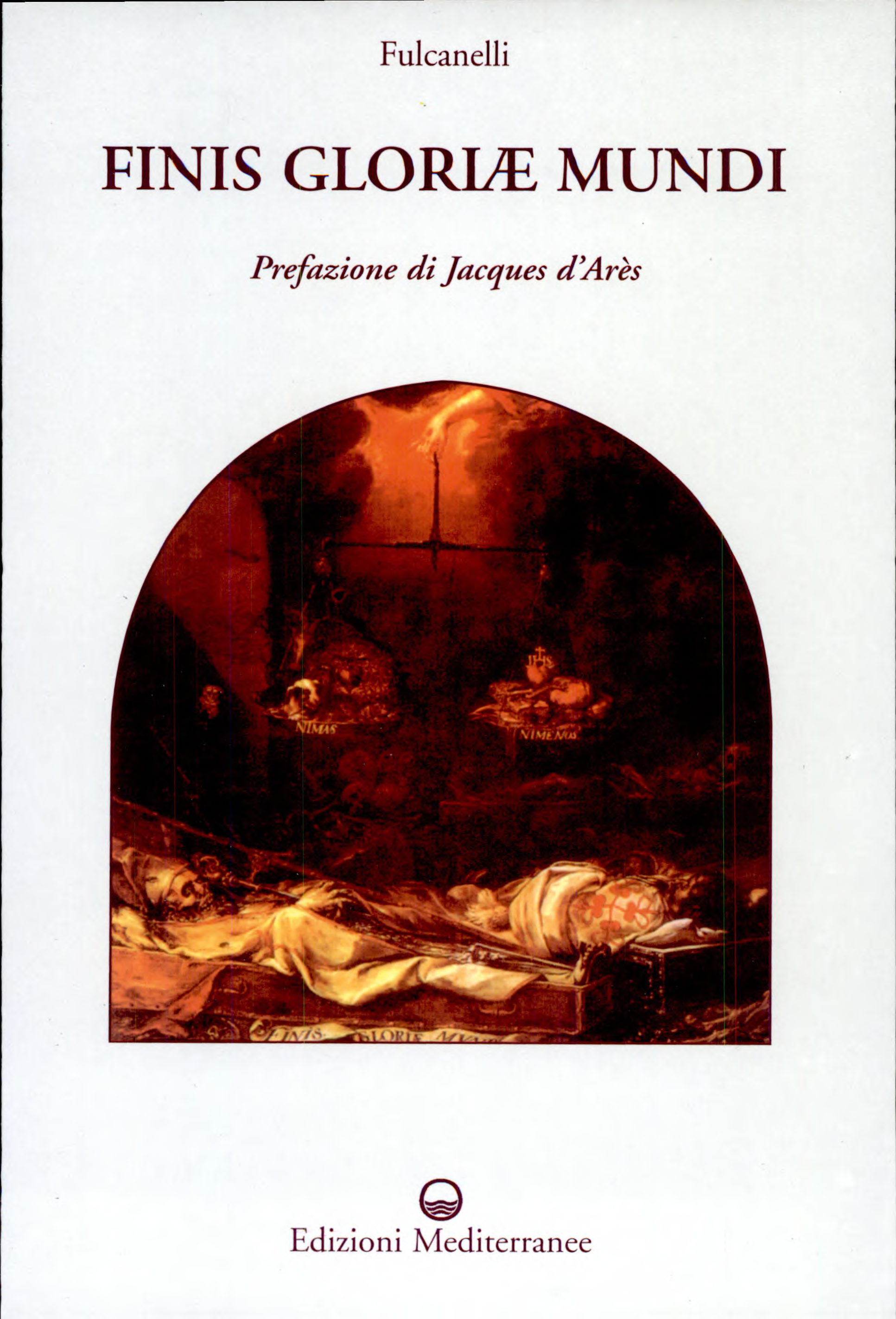Finis Gloriæ Mundi (lost esoteric book; existence unconfirmed; 1928)
Cover of the forged (?) book, published by Edizioni Mediterranee in 2007.
Status: Existence Unconfirmed
Finis Gloriæ Mundi is an alleged book by the enigmatic French alchemist Fulcanelli, which was to become his third published work after The Mystery of the Cathedrals (1926) and The Dwellings of the Philosophers (1929). However, according to Fulcanelli's disciple Eugene Canseliet, Fulcanelli eventually decided against publication and took away the notes for the book.
The name of the book is most likely derived from the eponymous 1672 painting by the Spanish artist Juan de Valdés Leal. A book with the same name, which used the painting by Leal as its cover image, was published in 1999; however, a number of analysts have concluded it to be a forgery.
History and contents
According to Canseliet, in 1922-1923, Fulcanelli handed him three parcels with handwritten notes that were to become three books. However, in 1928, Fulcanelli took back the third parcel with materials for Finis Gloriæ Mundi, apparently deciding not to publish it. In Canseliet's own words:
"It is only for Finis Gloriæ Mundi that a few notes were actually written, and they were not included in the parcel with the other notes. I don't know why. I have used those texts, since they were outside, in order to get an idea of what that third book might have been like. What it would have been in actuality, I have no idea. But Fulcanelli wanted the parcel back and he took it from me. Perhaps there were very serious matters in there."
Canseliet also stated that he included some of the materials from those notes in the last chapter of the second book, The Dwellings of the Philosophers.
After Canseliet's death in 1982, the French esoteric author Jean Laplace ostensibly found a number of documents in Canseliet's belongings relating to the unpublished book. The synopsis of the book, published by Laplace in 1988 in the issue №31 of the journal "La Tourbe des Philosophes", is as follows:
I. La décadence de notre civilisation et la déchéance des sociétés humaines (The decline of our civilization and the fall of human societies)
- Incrédulité religieuse et crédulité mystique (Religious disbelief and mystical belief)
- Effets néfastes de l'enseignement officiel (Harmful effects of State education)
- Abus des plaisirs par la crainte de l'avenir (Abuse of pleasure due to fear of the future)
- Fétichisme à notre époque (Present-day fetishism)
- Symboles plus puissants qu'autrefois dans la conception matérialiste (Symbols more powerful than in the past in the materialist conception)
- Incertitude du lendemain (Uncertainty about the future)
- Méfiance et défiance généralisées (General distrust and diffidence)
- La mode et ses caprices révelateurs (Fashion and its revealing whims)
- Les initiés inconnus gouvernent seuls (Unknown initiates are governing alone)
- Le mystère pèse sur les consciences (Mystery weighs upon consciences)
Témoignages terrestres de la fin du monde (Earthly evidence of the end of the world)
- Les quatre ages (The four Ages)
- Les cycles successifs scellés dans les couches géologiques (The successive cycles sealed in geological layers)
- Fossiles (Fossils)
- Flore et faune disparues (Vanished flora and fauna)
- Squelettes humains (Human skeletons)
- L'Asiatide (Asiatis)
- Monuments de l'humanité dite préhistorique (Monuments of so-called pre-historical mankind)
- Cromlechs
- Chandelier des trois croix (Three-cross candelabra)
Les causes cosmiques du bouleversement (Cosmic causes of the upheaval)
- Le système de Ptolémée (The system of Ptolemy)
- L'almageste (The Almagest)
- Erreur du système de Copernic démotrée par l'etoile polaire (Error in the Copernican system, demonstrated by the polar star)
- Précession des équinoxes (Precession of the equinoxes)
- Inclinaison de l'écliptique (Inclination of the Ecliptic)
- Variations inexplicables du pôle magnétique (Inexplicable variations in the magnetic pole)
- Ascension solaire au zénith du pôle et retour en sens contrire provoquant le renversement de l'axe, le déluge et la fusion à la surface du glove (Solar ascension at the pole zenith and return in the opposite direction, causing the reversal of the axis, the deluge and fusion at the surface of the globe)
In general, the book is believed to cover the topics of eschatology and the reversal of the Earth's magnetic poles.
1999 Book
In 1999, the occult scholar Jacques d'Arès arranged a publication of a book called Finis Gloriæ Mundi by the London-based publishing house Liber Mirabilis, claiming that it was Fulcanelli's original manuscript which he received by Email. However, numerous researchers concluded that the book was a fabrication due to the fact that its contents did not match the synopsis provided by Laplace, and included some references to recent events and scientific discoveries; moreover, it described an eschatological outlook entirely different from the one presented in Fulcanelli's other two books.[1] Besides, Canseliet stated that no copies of Fulcanelli's notes remain in circulation, and any published manuscript purporting to be his master's lost work is, by definition, a fabrication.
External Links
- Fulcanelli: His True Identity Revealed by Patrick Riviere
- Fulcanelli and the Alchemical Revival: The Man Behind the Mystery of the Cathedrals by Geneviève Dubois
- An overview of Finis Gloriæ Mundi at Due Passi nel Mistero (in Italian)
- The Italian edition of the forged Finis Gloriæ Mundi.
References
- ↑ A critique of the 1999 book by Jean-Pierre Thomas (in French). Retrieved 27 Dec '22
